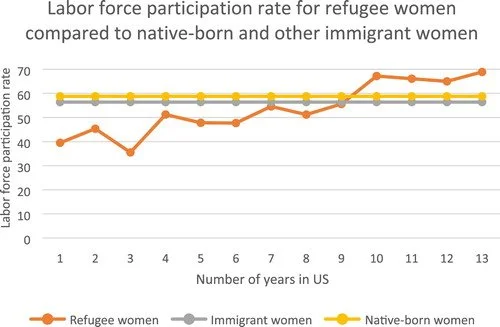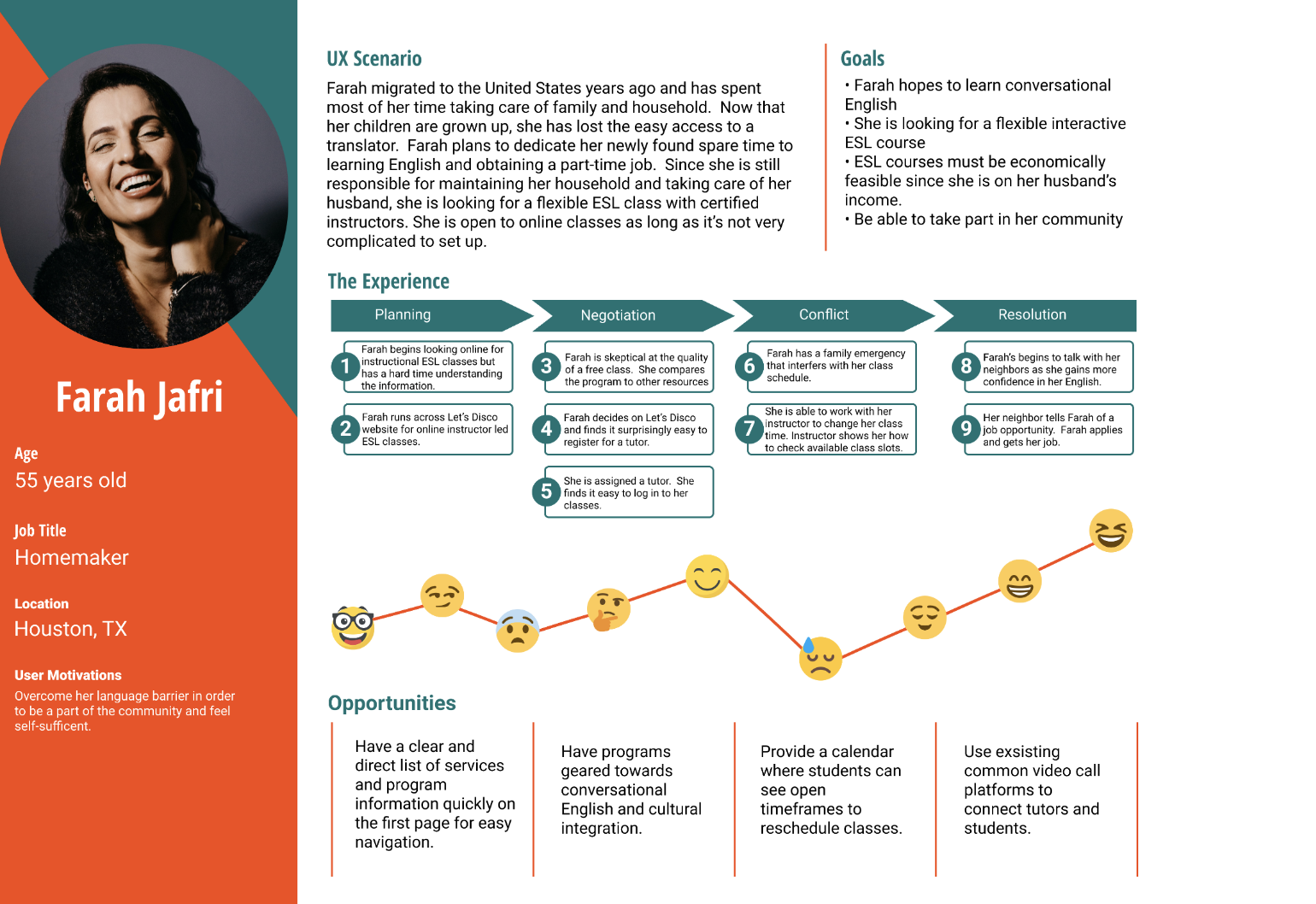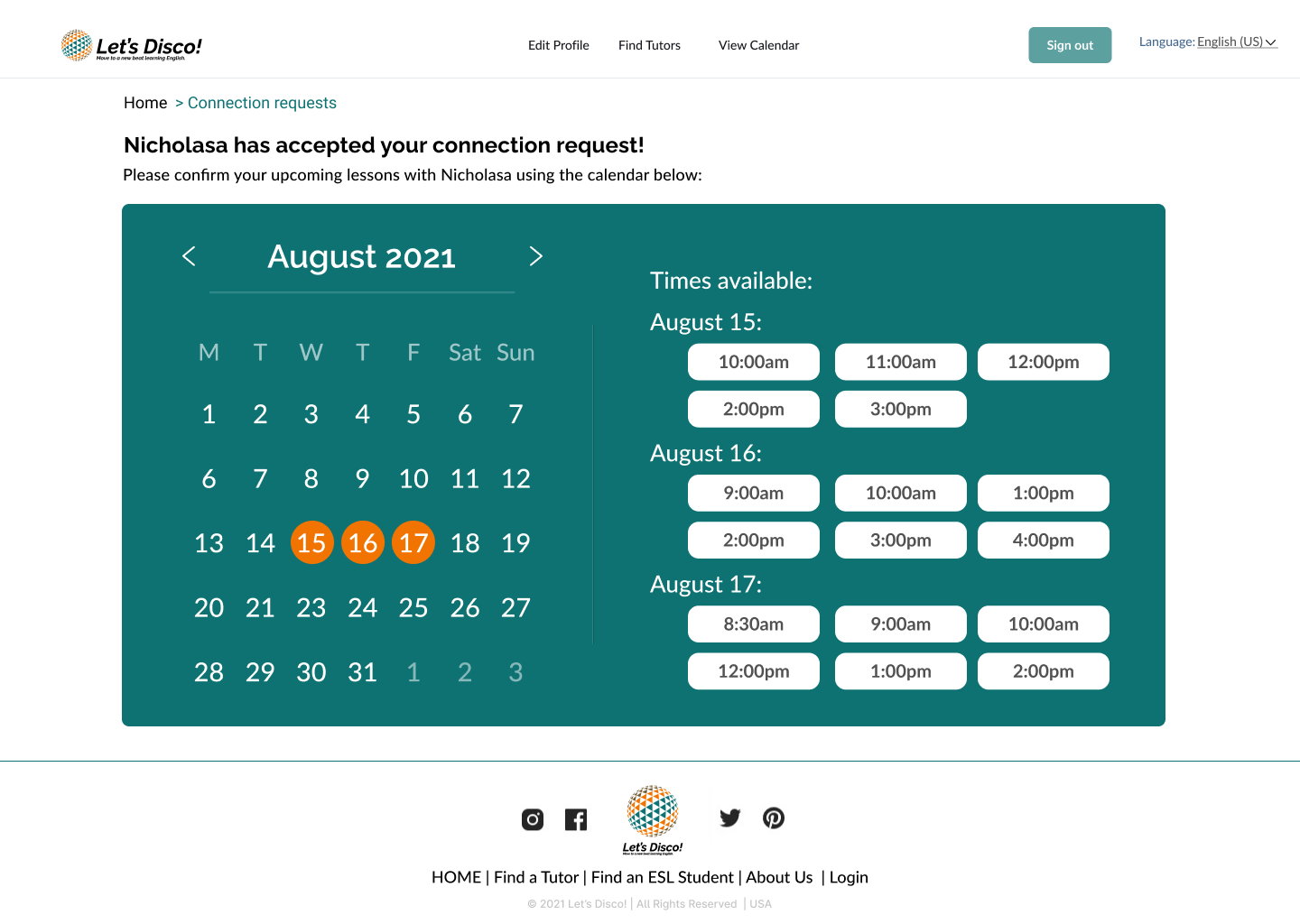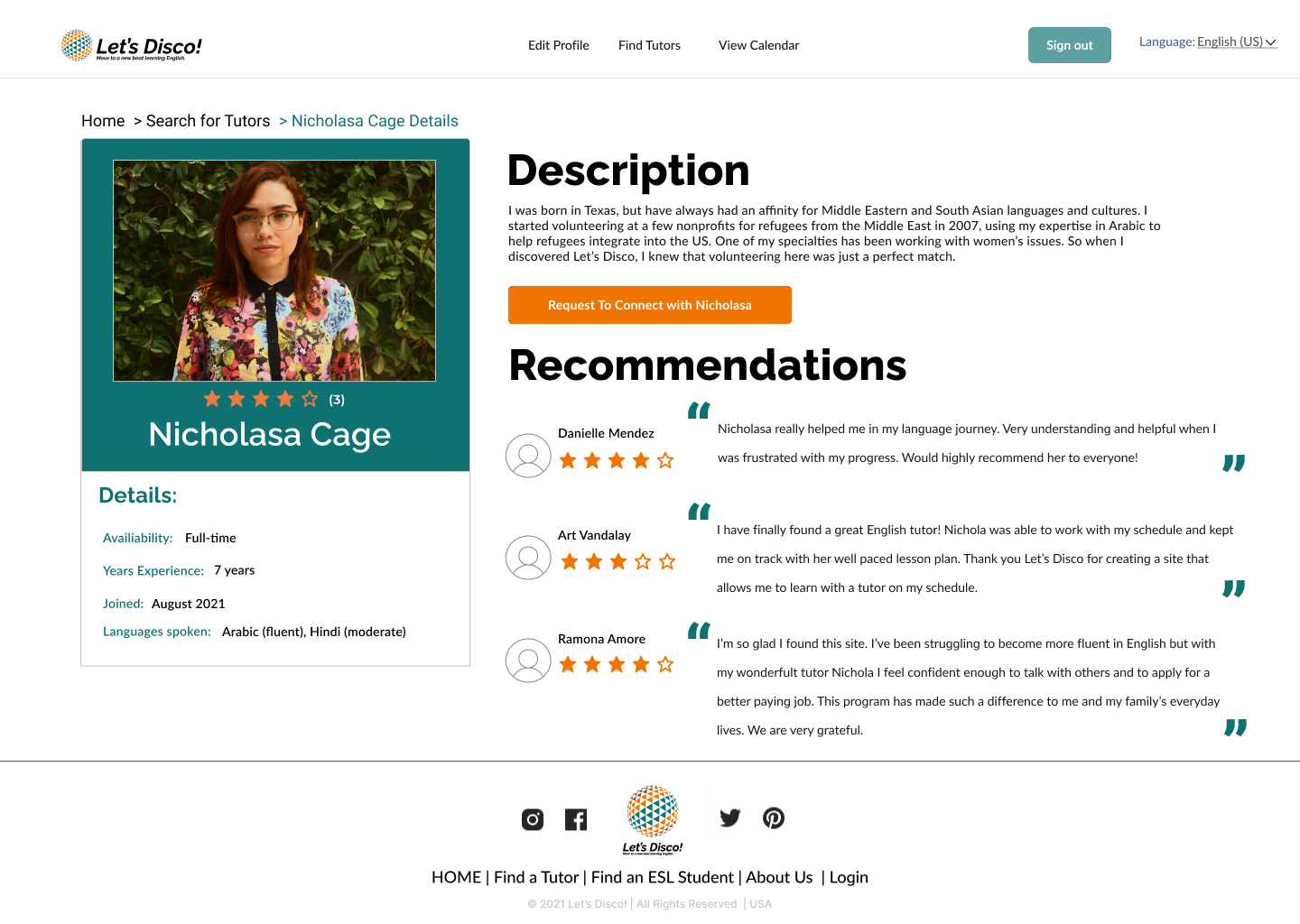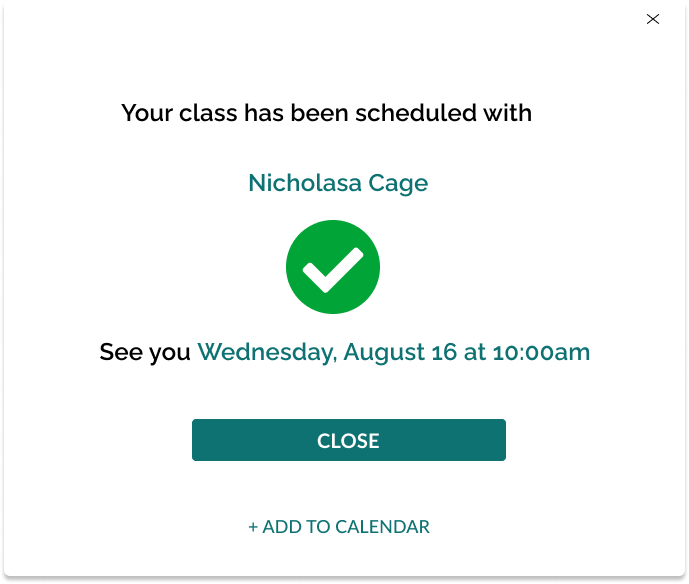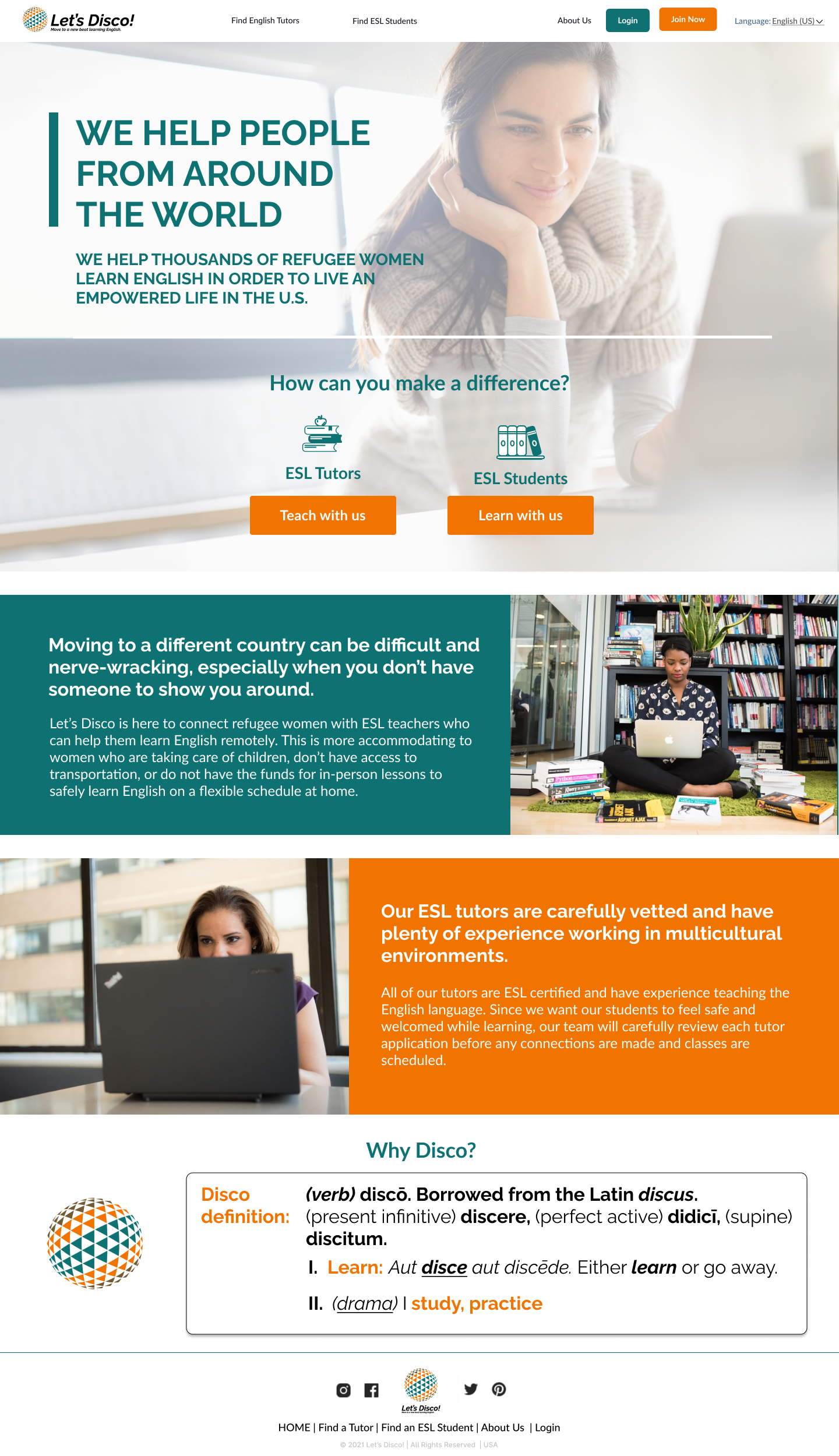📅 May 2021, revised March 2024 | 👩💻 UX designer and researcher | 🛠 Figma, Miro
💼 original product designed for online hackathon on addressing global women’s issues
Find English tutors online who’ll adapt to your busy schedule, free of cost.
For a hackathon geared at building tools for women, my team built a tool that connects refugee women with volunteer English tutors for flexible, one-on-one online lessons, accomodating users who may be isolated, overwhelmed, and unfamiliar with digital tools.
By matching learners with tutors who can work around their schedules and provide personalized support, the platform helps remove logistical and emotional barriers to learning, opening up more opportunities to access education, employment, healthcare, and more.
😩 Problem: Refugee women face certain emotional, cultural, and logistical barriers to attending in-person English lessons, making it harder to navigate the essentials of life in the US such as education, employment, healthcare, and more.
😀 Solution: An online platform uniquely for refugee women to locate vetted ESL tutors to enable them to build language skills with a flexible schedule, resulting in greater confidence and infinitely more open doors.
What is it currently like for refugee women to learn English in the US? What are their challenges?
Primary user research findings:
One of our team members had a strong network of several refugee women from all over the world. Four of us researched the challenges refugee women face in integrating in the US and learning English. Two other team members collaborated in interviewing six refugee women. We put all these findings together on an affinity map.
Key findings:
Click to expand photo
More than half of our participants emphasized:
⏰ A lack of time fitting English classes in their schedules due to the responsibilities of juggling childcare and work
💼 The necessity of learning English to better understand laws, employment, communities, and local culture
😢 Feeling homesick, struggling to connect with their new environment
👩🏫 A preference to learn English with a tutor rather than alone so they can be guided and corrected
🕘 A retroactive note as of May 2025: if I could redo this project, I would also ask participants many more questions, particularly ones pertaining to their previous strategies and barriers attempting to learn English digitally and in-person.
50% of immigrant women don’t leave their home for the first 6 months after immigrating
⬅️ Refugee women are typically fleeing political conflicts from a wide variety of countries (see table)
Refugee women often lag behind refugee men in learning English
Costs, excessive responsibilities, and illiteracy can sometimes hinder learning English for refugee women
Sometimes refugees do not have enough contact with native English speakers making it hard to practice sufficiently
Quality personal relationships between the women and teachers were valuable and motivational
Refugees often have their educations interrupted by violence, war, poverty, and other factors causing them to flee, which can disrupt their English education as well
⬅️ Refugee women tend to participate less in the labor force compared to US-born and other immigrant women (see graph)
73% of refugee women experienced increased domestic violence during COVID-19
Additional (online, secondary) user research:
Since our time to conduct primary research was limited, we primarily depended on secondary research online, expanding our search to “immigrant women” in general as data on refugee women is relatively limited.
We stepped into our users’ shoes together, walking through their struggles, hopes, goals, and barriers to learning English.
Design objectives
A lively yet comforting, warm design that makes it easy to find a tutor with the right qualifications and background. Scheduling needs to be a simple and flexible experience with easy cancellation.
An inclusive, empowering user experience that welcomes very diverse cultural backgrounds, including users not well-versed with technology.
⚠️ Important note: Since immigrants already face plenty of discrimination in the US for not speaking English well, it’s critical that the design does NOT further reinforce stigma against not knowing English or make users feel guilty for missing lessons like Duolingo, whose user experience has been criticized for being unusually pushy towards users.
How might we meet these objectives?
Color scheme to show liveliness
We decided that our interface would embody an uplifting, bright, joyful, and hopeful energy and experience while still being somewhat gentle enough to be comforting. A semi-bright color palette that isn’t too glaring would fit.
We used the image on the right as inspiration for our vivacious color scheme.
Imagery to convey peace
To keep up with the comforting, uplifting theme, we decided to call our platform Let’s Disco. You already know what “disco” popularly refers to in everyday life, but it also means learning in Latin!
In our project name, “disco” serves as a double-entendre to convey both learning and liveliness.
We decided to balance out the bright colors by featuring imagery of the white poppy, which is a feminine-presenting symbol of peace representing a commitment to non-violence and a world free from conflict.
In our research, we learned that many of our potential users have fled conflict-ridden regions. To contrast, we chose to feature the white poppy as a symbol of hope and resilience. Its presence on our site can convey a message of solidarity to honor the collective desire for a peaceful future and the pursuit of education and empowerment as pathways to healing.
Other symbols we considered was the white dove, the Flower of Life emblem, and paper cranes.
Product name
The mockups - homepage, tutor search
We wanted the site’s purpose to be immediately clear and welcoming ➡️
From our interviews, we thought it was important to emphasize learning safely at home on a flexible schedule since scheduling was a concern for our participants ➡️
Our participants emphasized the tutor’s certified background, so we made it clear our ESL tutors are vetted and certified ➡️
🕘 A retroactive note as of May 2025: I would have written the copy here to sound warmer, conveying more solidarity in an emotionally engaging manner rather in a plain matter-of-fact manner depicted here.
Additionally, the header text does not make it clear what the product does.
Searching for a tutor
It’s really important that the tutors have a space to describe themselves so the users can get a glimpse of their personalities and their familiarity with issues refugees often face.
On their end, tutor users will be prompted to enter their experience working with refugees and how they keep their lessons engaging, such as particularly unique, dynamic ways of immersion ➡️
⬅️ Our online research indicates that cultural competency in a tutor would also be important, hence mentioning their experience in multicultural environments
⬅️ Our research shows that refugees come from many countries, so it’s important that the website can be translated into several languages and the user can easily search tutors by languages spoken.
Note: one of the first steps for a user to creating their new free account would be selecting the language they speak, thus setting the language for the overall site. They can change it in the right corner.
⬅️ One of our research insights is that precise scheduling would be important to our users, so we presented our instructors’ availability in clear slots similar to a typical calendar scheduling app
🕘 A retroactive note as of April 2024: As mentioned before, I would have conducted more research on the refugee women’s previous use of online ESL platforms and what they seek out most in a platform. That way, I would be able to add more useful filters and more advanced methods of searching for the right tutors.
Since scheduling and instructor background was a key concern for our participants, we added clear ratings and current weekly availability as reported by the tutors ➡️
A retroactive note as of April 2024: If we had more time, we would have asked more technical, granular questions their previous experiences with tutors. For example, tutor profiles could feature what platforms the tutor uses and what parts of English they specialize in.
Hypothetical KPIs
Since this was an entirely remote hackathon spanning only two weeks, our team did not have the opportunity to perform user testing. But if we did, here’s what we’d look for:
🤔 To measure the success of this product, we would look at:
onboarding completion rate
first lesson booking rate
return rate of both students and tutors
search completion time
how often users refine their searches
most and least-used filters and types of search terms (genre, style, community, sound, mood, etc)
mutual satisfaction between students and tutors — certain forms of dissatisfaction may indicate not enough information is being provided
user reviews, especially feature complaints and requests
referral rate
language improvement by user
most importantly, real-world impacts of improved English proficiency
🏆 Hypothetical wins would look like:
as search filters are refined — users reducing the overall time they spend finding the right tutor, as well as reducing the time spent in the overall cycle of hiring and completing the payment
users praising in the reviews “this made it so much easier to find the right person who align with my background!”
positive reviews from a wide variety of users, including refugee women across multiple cultures and levels of English proficiency
low drop-off rates from initial signup to setting up recurring lessons
students report feeling safe and comfortable with culturally and emotionally sensitive tutors who understand their situations
students report major life improvements from increased English proficiency mainly due to this platform, such as being able to navigate important appointments with dramatically reduced anxiety
Hypothetical future considerations
If I were to further build this product with unlimited resources, I would include:
A section on a page that describes the benefits of learning English to further entice users
Another section describing how Let’s Disco vets its tutors to provide more assurance to our users the platform is safe
A dashboard for the user to keep track of her English classes, feedback, and overall progress to show the app’s impact
In-app features to practice reading and writing English, such as a feature for the tutor to assign homework digitally to streamline usability with the user’s everyday life
More visual symbols of peace featured throughout the site for a calming, reassuring effect
A mobile version with push notifications that remind the user to practice English (again, not in a mean way like Duolingo)




